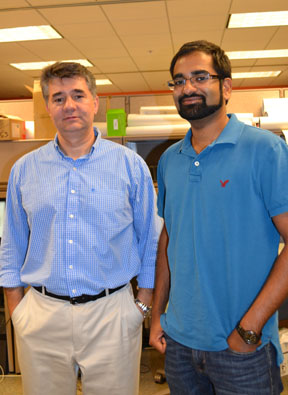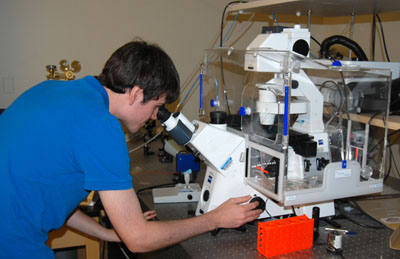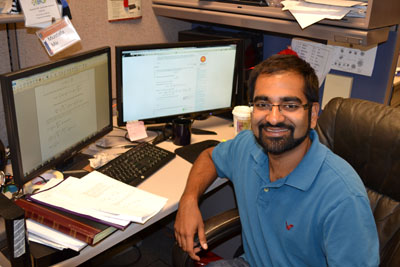EBICS REU Student Contributes to Research on Neuron Cells

Ryan Tapping, Illinois undergraduate student.
September 27, 2012
Rather than lazing the summer away like some of his peers, Ryan Tapping, an Illinois undergraduate student, spent his productively—making a significant contribution to research. The experiment? Studying how neuron cells from a rat brain form clusters.
Participating in the National Science Foundation's (NSF) Research Experience for Undergraduates (REU) program, Tapping worked with faculty member Gabriel Popescu, who is part of EBICS (Emergent Behaviors of Integrated Cellular Systems), an NSF Science and Technology Center which fosters research where systems biology converges with engineering. Was undergrad Tapping able to contribute to the research? Significantly.
The original plan to analyze the data involved an onerous task: having someone (possibly Ryan?) count the number of cells that were in clusters versus the number of cells not in clusters. Instead of counting them manually, Tapping wrote an image processing algorithm to automate that process. His algorithm first found all the cells in the image, then figured out which of them were alone and which were part of a cluster.
Was writing the algorithm a big deal? According to graduate student Mustafa Mir, his lab mentor, it was pretty impressive: "He is very independent, so I gave him the idea, and gave him a book that describes how to do this, and he figured it out on his own."

Professor Gabriel Popescu and grad student Mustafa Mir
Both Mir and Tapping work in researcher Gabriel Popescu's lab in the Beckman Institute, which uses imaging tools to answer biological questions. Over the last few years, the lab has designed several new instruments that allow researchers to look at biological systems in a labor free, quantitative manner. Rather than just an image, researchers actually get information on each pixel. One major instrument developed in their lab is the SLIM (Spatial Light Interference Microscope). Mir explains that it enables researchers to measure a biological system's properties in a non-invasive, label free manner, and in this particular study, "to understand how neural networks form in a developing nervous system."
Why rat brains? According to Mir, "Using a rat model for this type of research is very useful and commonly practiced since the early stages of development are very similar to what happens in humans and since for very good reasons, we don't have easy access to living human brains!"
Mir goes on to explain that their study "will have far reaching implications both in learning how to control the behavior and organization of these networks and also in the understanding of various neural disorders." Their EBICS-related goal? To understand how neurons organize so they can be used as control units for biological machines.
According to Popescu, their neuron study can have also have implications on computer design: "Understanding better how our brain cells cooperate will revolutionize the way computers work as well. For the past decades, the computer chips were made faster by simply manufacturing smaller structures. Clearly, there is a fundamental limit to how small the structures can be made, say, the size of an atom. However, there is a vastly unexplored direction, which is getting more chips to work together in parallel, in the same way our neurons work. For example, each neuron is orders of magnitude slower than a phone chip. However, the brain as a whole, containing 100 billion neurons working together, can perform tasks that exceed even the fastest supercomputer today."
Tapping's summer stint as an REU wasn't his only exposure to the Popescu lab. He worked there prior to this summer and has continued through the fall. Although he had already been exposed to lab research, he acknowledges that this summer was an especially positive experience.
"The way the EBICS program was organized, it was basically going through the entire scientific process over the course of the summer, which is tough to do. To get a PHD, you have to spend six years doing this, right? But we started with a proposal—what kind of research we planned to do, what kind of materials and methods we were going to use to achieve those goals. Then, throughout the summer, we carried out some kind of experiment, did some analysis. By the end, we gave a poster presentation. We had a paper to write emulating a publication. It is very hard to do all of that within a single summer. But it was a great experience, because you are able to see how the whole process goes from start to finish. You are able to get a good idea of what research is all about and what you are able to do with it."

Tapping uses the SLIM to analyze neuron cells.
A physics major, Tapping found applying his skills to the field of biology to be very rewarding. "This was very unique, because it incorporates all of the physics knowledge that I know with the microscopic techniques, and basically it is all being applied to study these biological specimens from a new point of view that hasn't been seen before."
Having had the opportunity to work closely with Tapping through the summer, Mustafa Mir, an electrical engineer by training, who has worked on the development of tools but recently shifted to bioengineering, hopes the REU program continues and that they get more REU students in the lab. According to Mir, one of the benefits of working with REUs is practicing communicating about their research in terms others, possibly new to the field, can understand. "Because we sit here every day, all year, and it is nice to have somebody else new—not really a fresh perspective—but it is a chance for us to distill things down so we can explain it to somebody…That really makes you step back a little bit as well."

Grad student Mustafa Mir, Ryan Tapping's REU mentor, at work in his office in Beckman Institute.
Mir, whose EBICS-related project is working with neurons, but who is also conducting research on breast cancer and blood screening, also seeks to impart his passion for his work to young researchers: "I think it is exciting to see them get excited about our research…Because if you are doing something all day, you are going to get excited about every small detail. If somebody comes in and says, "Oh, who cares that this cell is behaving like this?" you have to give them your perspective."
Was Mir able to transmit his excitement to his young protégé? Yes, but when prodded regarding whether some of the research had been boring, Tapping was also realistic: "There are always parts that you have to chug through, right? There are parts that—you know your goal, you know how you have to get there, and you don't want to do it all, but you know you have to. There are boring parts; there are exciting parts."
After his experience this summer, might Tapping choose to go into this field? "It is hard to say. I am always wondering what my future would be like, but it is definitely something that I am interested in, especially the optics, being able to use these optics for basically looking at anything. That is the goal—to see everything in all its detail. These kinds of applications are very awesome."
Having had a positive summer himself, Tapping recommends his REU experience with EBICS to other undergrads. "Yeah, I would definitely say that everyone that wants to do research is obviously looking for research opportunities, right? EBICS is a great one."
Author/photographer: Elizabeth Innes, Communications Specialist, I-STEM Education Initiative
More: EBICS, REU, REU: EBICS, Student Spotlight, Summer Research, 2012
Photograph of Ryan Tapping and the SLIM courtesy of Ryan Tapping.













.jpg)
















